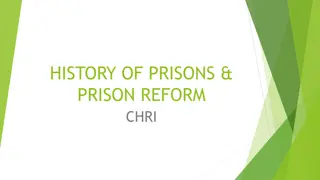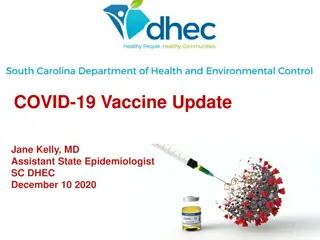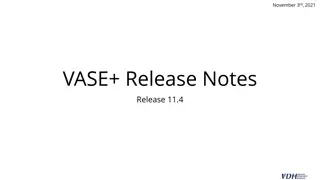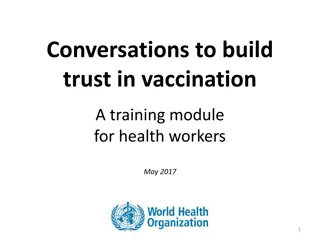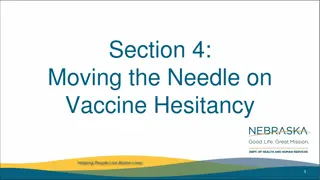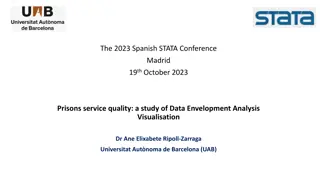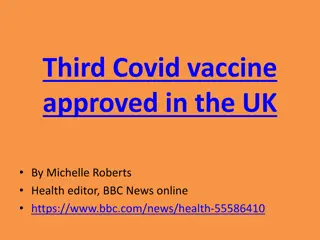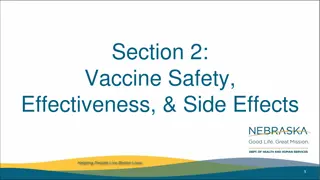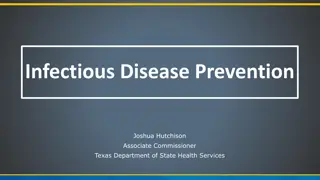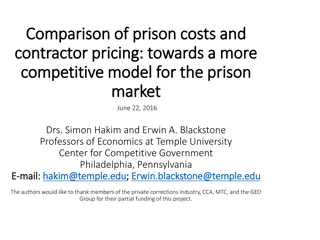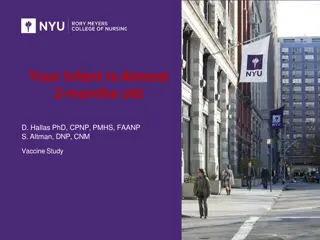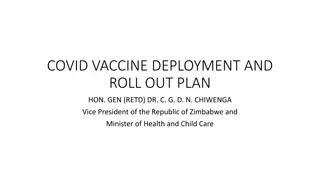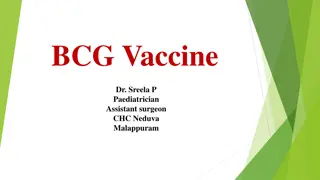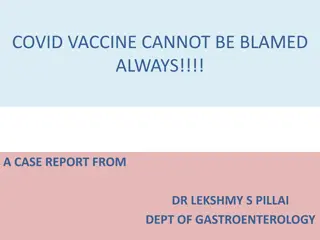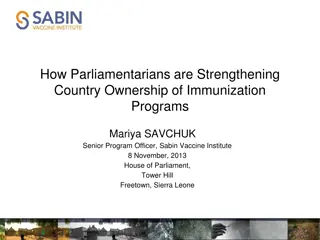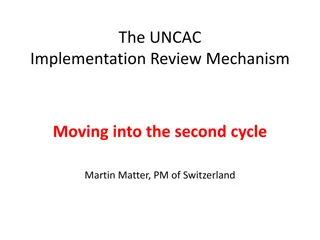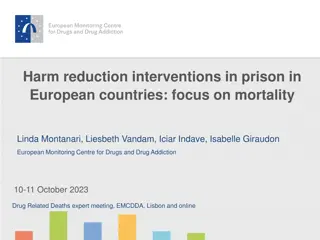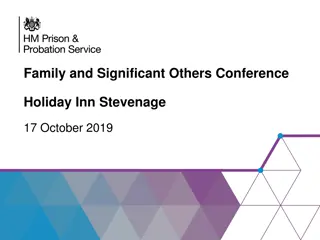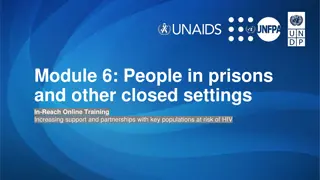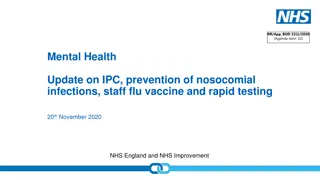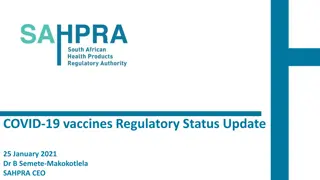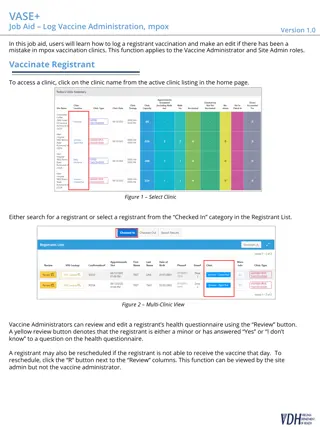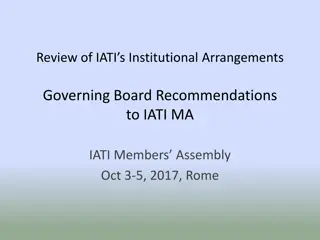Review on Vaccine Hesitancy in Prisons: Data Analysis & Recommendations
This review delves into the issue of vaccine hesitancy across prisons, aiming to provide recommendations to address the decline in vaccination rates. Utilizing data from 20 sites with high decline rates and 5 sites with high uptake rates, the analysis examines factors like geography, ethnicity, and age to combat hesitancy effectively. Significant findings point to increased decline rates in NHS regions, highlighting the need for targeted strategies to achieve Public Health England's vaccination target.
Download Presentation

Please find below an Image/Link to download the presentation.
The content on the website is provided AS IS for your information and personal use only. It may not be sold, licensed, or shared on other websites without obtaining consent from the author. Download presentation by click this link. If you encounter any issues during the download, it is possible that the publisher has removed the file from their server.
E N D
Presentation Transcript
COVID-19 A Thematic Review into Vaccine Hesitancy across the Prison Estate 06 May 2021 OFFICIAL SENSITIVE
What do we want to achieve? The aim of this review is to utilise our findings to set out a series of recommendations aimed at addressing vaccine hesitancy and to assist with meeting Public Health England (PHE) target of 90% or more prisoners vaccinated, in order to reduce transmission, prevent outbreaks and progress the regime. 20 sites have been identified with vaccine decline rates above 20% based on NHS data 5 sites have been identified with high vaccine uptake rates based on NHS data We have gathered local data from these sites to bolster the NHS data and provide a more comprehensive overview to better understand patterns and trends within the data. Data granularity has enabled us to achieve a detailed review, looking closely at factors such as ethnicity, gender, age, prison function and geography. OFFICIAL SENSITIVE 2 Age cohorts :DASD 18/01/21 P NOMIS
The graph below provides a comparison between both local and NHS decline rate data for those prisons with decline rates above 20% Prison Vaccine Decline Rate Data - High Decline Rate Sites 60% 50% 40% 30% 20% 10% 0% Local Decline Rates NHS Decline Rates 3 OFFICIAL SENSITIVE
The graph below provides a comparison between both local and NHS decline rate data for those prisons which engaged with decline rates below 5%. Prison Vaccine Decline Rate Data - Low Decline Rate Sites 30% 25% 20% 15% 10% 5% 0% HMP Ashield HMP/YO Highdown (Mass Vacs) HMP Wealstun HMP Buckley Hall HMP Thameside HMP Styal NHS Refusal Rates Local Refusal Rates 4 OFFICIAL SENSITIVE
What have we learnt from the data? To better understand the decline rate data across the prison estate we have looked across a selection of sub-categories. These provide granularity within the data analysis and establish any trends, with an overarching view of combating vaccine hesitancy. Findings by sub-category are set in the following sections: Geography Ethnicity Prison Category/Function Age/Gender OFFICIAL SENSITIVE 5
Geography Prisoner decline rates among each NHS region have increased significantly between 8th March and 15th April 2021. NHS Regions Vaccine Hesitancy 08.03.21 Vaccine Hesitancy 15.04.21 Local data shows an increase in decline in line with the rollout of the vaccine to cohort 6, namely young people who are less engaged. East of England 9% 17% London 24% 34% Midlands 12% 20% The explosion of media content surrounding Astra Zeneca and blood clots is also in line with the increase in decline rates over these two dates. North East and Yorkshire 8% 13% North West 14% 15% South East 15% 25% South West 5% 12% 6 OFFICIAL SENSITIVE
Geography Community and Prison Vaccine Hesitancy by Region 39% Community regional data shows that London has the highest refusal rate at 9%, whilst the South West and North East has the lowest at 4% and 6%. 40% 35% 30% 25% 25% NHS prison regional data shows London prisons has the highest decline rate of 39%, comparative to 10% and 13% in the South West and North East and Yorkshire respectively. 20% 20% 17% 17% 13% 15% 10% 9% 8% 7% 10% 6% 6% 5% 4% 5% 0% East of England London Midlands North East & Yorkshire North West South East South West NHS Regional Prison Vaccine Hesitancy - 15.04.21 Community Regional Vaccine Hesitency - 31.03.21-25.04.21 7 OFFICIAL SENSITIVE
Ethnicity Prison and Community Decline rates based on Ethnicity Here we see vaccine hesitancy amongst ethnic minority groups in the community intensify within the custodial environment. Whilst decline rates amongst the white prison population are statistically more significant, the 17% increase on community hesitancy rates amongst the Black or Black British community within prisons means almost 1 in every 2 prisoners from this ethnicity group are declining the vaccine. 47% 50% 40% 45% 40% 34% 30% 35% 26% 30% 25% 17% 20% 12% 15% 10% 9% 6% 10% Trust is eroded by systemic racism and discrimination, previous unethical healthcare research in black populations, under- representation of minorities in health research and vaccine trials, and negative experiences within a culturally insensitive healthcare system (BMJ). 5% 0% White Black or Black British Asian or Asian British Mixed or Multiple Ethnic Groups Chinese or Other Ethnic Groups Prison Vaccine Decline rates by Ethnicity Community Vaccine Decline rates by Ethnicity ONS vaccine hesitancy by Ethnicity 31.03.21-25.04.21 8 OFFICIAL SENSITIVE
Ethnicity Looking at the prisons with decline rates over 20% we can see that six out of the top ten sites with the highest decline rate also have the highest percentage of BAME prisoners making up their population. These six sites are Isis, Huntercombe, Aylesbury, Brixton, Onley and Pentonville. HMP Thameside is an outlier within our data, having the third highest BAME prisoner population across the prison estate but an 18% vaccine decline rate. This decline rate, whilst still high, is significantly lower than other prisons with high proportion BAME populations and is the lowest decline rate amongst the London prisons. Of note 90% of Thameside s Healthcare staff are BAME, which may have assisted in their relatively high uptake rate. Peer influence has been proven to positively effect vaccine uptake as it feeds into the idea of social norms and may go some way to explain this trend at Thameside. 9 OFFICIAL SENSITIVE
Prison Category/Function The below table shows decline rates from 26th March to 15th April based on prison function. From local feedback we have seen significant vaccine decline rates in Cohort 6 compared to all other cohorts in 2-9. Negative parental influence is strongly affecting young adult s reasoning. Concerns regarding fertility and pregnancy are linked to this decline in young adult, with the negative media hysteria and fake news. Prison Function Decline Rates 08.03.21 6% 17% 8% 11% 9% 17% 4% 13% 6% Decline Rates 15.04.21 10% 15% 9% 21% 16% 34% 15% 27% 10% Female Closed Female Local Female Open Male Category B Male Category C Male Closed YOI Male Dispersal Male Local Male Open Privately Managed Prisons (PMPs), specifically Serco managed prisons, have been identified as performing well with vaccine uptake. Serco manage five prisons in England and Wales, three of which are prisons with high uptake rates. These include Ashfield, Thameside and Lowdham Grange. 10 OFFICIAL SENSITIVE
Age/Gender There is a 10% decline rate for people aged 16-29 in the community, this drops to 1% for those over 70. Female decline figures from the community are not commuted into Prisons. Instead, the Female Estate has the highest vaccine uptake rate. Noticeably female estate has an average decline rate of 11% whereas male YOI (18+) prisons have a 34% decline rate. 11 OFFICIAL SENSITIVE
Conclusion and Recommendations When looking at our study we can see that community trends such as age, ethnicity and locality are commutable to the custodial environment. Noticeably we see that community trends regarding female uptake is not mirrored in Prison data. It is important to understand that the data available to us is flawed, therefore making it difficult to accurately analyse and establish trends. Local data has highlighted this and has gone someway to achieving a better understanding of vaccine uptake. Community research suggests that vaccine scepticism is linked to a wider crisis of trust. This is not exclusive to Covid 19 and forms part of historical trends concerning vaccine uptake. We can see that this trust or lack of trust is amplified within a custodial setting. It is important we continue to build trust in prisons through: Clear and consistent communication and education from trusted and credible sources. Positive peer influence. Positive staff relationships. Positive vaccination experiences at a practical level. 12 OFFICIAL SENSITIVE
Conclusion and Recommendations Identifying future problems As we start emerging from peak lockdowns, the importance of vaccinations become less prevalent (false sense of security). Now we are targeting vaccination towards younger and healthier adults too, the personal benefits become less obvious to those individualists who do not see the bigger societal picture in terms of the vaccination process. When I speak to people who are enthusiastic about vaccination, the first thing they say is that it helps everyone. In contrast, people wary of a vaccine often focus on their own situation: they ll tell me that they re unlikely to fall ill, for example, or worry about what may go wrong if they were to take a vaccine. But this perspective can change; when I ve asked vaccine-hesitant individuals to imagine that someone close to them is especially vulnerable to COVID-19, they say that they re more likely to get vaccinated. Recommendations Further explorative work into female refusal rates in custody compared to higher rates in the community. Further explorative work into BAME Healthcare staff and the correlation between BAME vaccine uptake in custody. Consistent and accurate communication to address existing and emerging fears in line with the current staff and prisoner Newsletters. Specific comms to address the upcoming cohorts, namely young adults. A strategic approach in harnessing peer influence/support. Doctor Daniel Freeman, Professor of Clinical Psychology at the University of Oxford. 13 OFFICIAL SENSITIVE




